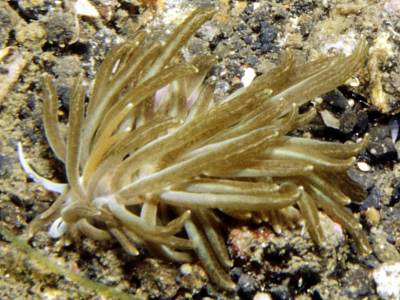
Phyllodesmium sp. 9
Order: NUDIBRANCHIA
Suborder: AEOLIDINA
Family: Glaucidae
PHOTO
Jahir, Lembeh Straight, Sulawesi, Indonesia., July 2002. Depth: 40 feet, Length: 2.5 cm. Photo: Marli Wakeling
This looks to be another unknown species. It has similarities to Phyllodesmium briareum, especially in the way the zooxanthellae in the cerata seem to be arranged in parallel rows along the ceratal wall, but I think the very long rhinophores may prove to be distinctive.
Authorship detailsRudman, W.B., 2002 (October 7) Phyllodesmium sp. 9 [In] Sea Slug Forum. Australian Museum, Sydney. Available from http://www.seaslugforum.net/find/phyllodsp9
Related messages
Phyllodesmium sp. 9 from Lembeh
February 17, 2007
From: Bruce Wight
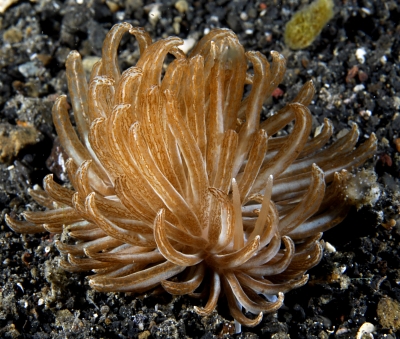
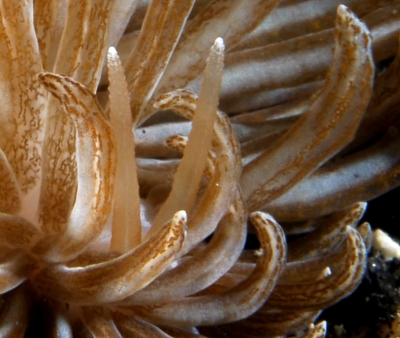
Dear Bill
Spent a week in Lembeh in mid November, saw many branchs that were new to me. I have sent photos of three species of Phyllodesmium that I thought would add to the Forum. I think this one is Phyllodesmium colemani
Locality: Lembeh Strait, 25-45 Feet, Sulawesi, Indonesia, Celebes Sea, November 2006, Crawling on reef . Length: 1-1 1/2 Inches. Photographer: Bruce Wight.
Thanks
Bruce Wight
bruce.c.wight@boeing.com
Wight, B.C., 2007 (Feb 17) Phyllodesmium sp. 9 from Lembeh. [Message in] Sea Slug Forum. Australian Museum, Sydney. Available from http://www.seaslugforum.net/find/19151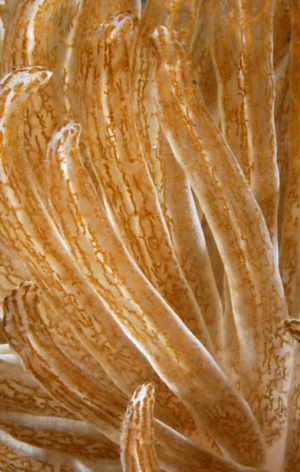
Dear Bruce,
The whitish bands on either side of the cerata are quite like those of P. colemani but in that species the brown on the cerata form aggregations of brown specks rather than the brown lines of your animal. If the brown was just a surface pigment it is possible that your animal is just a colour variation of P. colemani, but the brown colour is from the microscopic algae [zooxanthellae] which these solar-powered animals store in specialised branches of their digestive gland. Brown spots indicate the end of a digestive gland branch, while a brown line suggests a thin tube running along just under the skin. This means that your animal and P. colemani have rather different internal anatomies.
Another difference is that the cerata in P. colemani are arranged in small separated groups along each side of the body, while in your animal the cerata are much longer, more crowded, and more numerous. I suspect this is the species I am calling Phyllodesmium sp. 9
Best wishes,
Bill Rudman
Phyllodesmium from North Sulawesi
October 14, 2002
From: Marli Wakeling

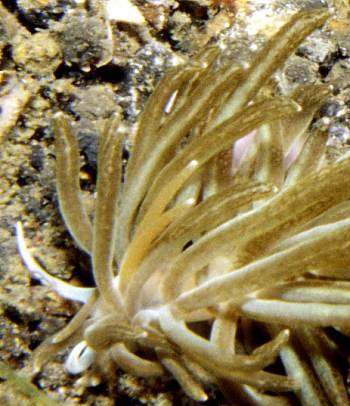
Hi Bill,
Here is a species of Phyllodesmium that I haven't been able to identify. It was found at night on sand near to a clump of soft coral polyps that it resembled.
Location: Jahir, Lembeh Straight, Suluwesi, Indonesia
Date: July 2002
Depth: 40 feet
Length: 2.5 cm.
Photograph: Marli Wakeling
Cheers,
Marli
scubamarli@excite.com
Wakeling, M., 2002 (Oct 14) Phyllodesmium from North Sulawesi. [Message in] Sea Slug Forum. Australian Museum, Sydney. Available from http://www.seaslugforum.net/find/8130Dear Marli,
This looks to be another unknown species. It has similarities to Phyllodesmium briareum, especially in the way the zooxanthellae in the cerata seem to be arranged in parallel rows along the ceratal wall, but I think the very long rhinophores may prove to be distinctive. If you by chance have another photo showing the soft coral it would be of interest.
Best wishes,
Bill Rudman
